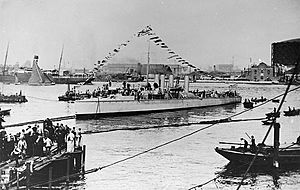Greek destroyer Thyella (1907) facts for kids

Thyella at her launch at Yarrows
|
|
Quick facts for kids History |
|
|---|---|
| Namesake | Storm |
| Ordered | 1905 |
| Builder | Yarrow Shipbuilders, Cubitt Town, London |
| Laid down | 1905 |
| Launched | 1907 |
| Commissioned | 1907 |
| Decommissioned | 1941 |
| Fate | Sunk by the Luftwaffe on April 21, 1941 |
| General characteristics | |
| Class and type | Thyella class destroyer |
| Displacement | Standard 350 tons |
| Length | 67.1 m (220 ft) |
| Beam | 6.2 m (20 ft) |
| Draft | 1.8 m (5 ft 11 in) |
| Propulsion | 2 shafts, 6,000 hp |
| Speed | 30-knot (56 km/h) maximum |
| Complement | 70 |
| Armament | Gun 2 × 3-inch (76 mm) 12-pounder Hotchkiss Single & Gun 2 × 57-millimetre (2 in) 6-pounder 40cal Hotchkiss QF Single |
Thyella (pronounced Thee-EL-la) was a special type of fast warship called a destroyer. Her name means "Storm" in Greek. She was part of the Royal Hellenic Navy, Greece's navy, from 1907 to 1941. Thyella was the very first ship in the Greek navy to have this name.
Building a Storm Ship
Thyella was one of four ships in her class, all named after storms. The Greek navy ordered these ships from Britain in 1905. Thyella was built at the Yarrow shipyard in Cubitt Town, London. She was launched in 1907, meaning she was put into the water for the first time.
Service in World War I
During World War I, Greece joined the war later on the side of the Triple Entente. This group included countries like France, Britain, and Russia. Because Greece had been neutral for a while, the four Thyella class ships were taken over by the Allies in October 1916.
The French navy used them from 1917 to 1918. By 1918, Thyella was back with the Greek navy. She helped protect other ships, mostly in the Aegean Sea. Thyella also took part in the Greco-Turkish War (1919-1922).
Final Days in World War II
Thyella continued to serve in World War II. Sadly, she was sunk during the German invasion of Greece. On April 21, 1941, German planes from the Luftwaffe (the German air force) attacked and sank her. This happened off the coast of Vouliagmeni, which is near Athens.
See also

